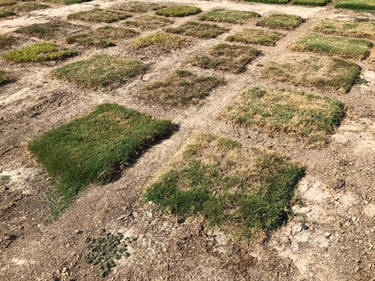
Unirrigated plots in late July of 2018. The unirrigated plots were strictly rainfed after establishment. Photo Credit: Reagan Hejl
ALEXANDRIA, VA - Water used for outdoor purposes such as turfgrass irrigation can comprise up to 30-60% or higher of domestic water uses, depending on geographic location. Landscape irrigation frequency restrictions are commonly imposed by local and municipalities to curtail domestic water use and to ensure adequate water supplies for growing populations during times of drought. Currently, published data are lacking concerning irrigation frequency requirements necessary for sustaining acceptable levels of turfgrass quality of commonly used warm-season turfgrass species.
Sensor control irrigation is an important topic in specialty crop research. Levin and Nackley compared commonly used tools and discussed proper usage of each.
The objective of this 3-year field study was to determine comparative turfgrass quality of drought-resistant cultivars of four warm-season lawn species in the south- central United States under various irrigation frequencies. This study sought to determine minimal irrigation frequencies needed to support acceptable aesthetic quality of commonly used warm-season turfgrass species. According to Reagan Hejl, Research Agronomist at the U.S. Arid Land Agricultural Research Center in Maricopa, AZ, "We feel the results of this study are useful since we took a very relatable approach to irrigation management and have data over multiple years."
This study, supported through a grant from the U.S. Department of Agriculture Specialty Crops Research Initiative, was conducted from 2016-2019 at the Texas A&M University Turfgrass Field Research Laboratory, College Station. The grasses chosen for the study included St. Augustinegrass, bermudagrass, zoysiagrass, and seashore paspalum, which are widely used warm- season turfgrass species.
The first year was an establishment period and the plots were irrigated 2-3 times weekly to encourage grow-in and prevent wilt. The irrigation frequency treatments of 0, 1, 2, 4, and 8 times monthly were imposed from July through October of year 1, late May through October of year 2, and from late May through August of year 3. The irrigation was applied between the hours of 10 pm and 8 am using cycle soak methods to prevent water runoff.
The only water the unirrigated plots received after the establishment period was from natural precipitation and was recorded for the purposes of this study.
The results from this 3-year field study indicate that, on average, the warm-season turfgrass species used were able to maintain acceptable visual quality while being irrigated at frequencies limited to once per week in a central Texas climate. Species selection becomes an important consideration once irrigation is limited to frequencies less than once per week.
Continued research in this area is important for helping to better understand species limitations to irrigation restrictions. These studies will become increasingly important as municipal irrigation frequency restrictions become more common.
The complete article is available on the ASHS HortScience electronic journal web site: https://doi.org/10.21273/HORTSCI15978-21
About the American Society for Horticultural Science
Established in 1903, the American Society for Horticultural Science is recognized around the world as one of the most respected and influential professional societies for horticultural scientists. ASHS is committed to promoting and encouraging national and international interest in scientific research and education in all branches of horticulture. Comprised of thousands of members worldwide, ASHS represents a broad cross-section of the horticultural community - scientists, educators, students, landscape and turf managers, government, extension agents and industry professionals. ASHS members focus on practices and problems in horticulture: breeding, propagation, production and
management, harvesting, handling and storage, processing, marketing and use of horticultural plants and products. To learn more, visit ashs.org.






